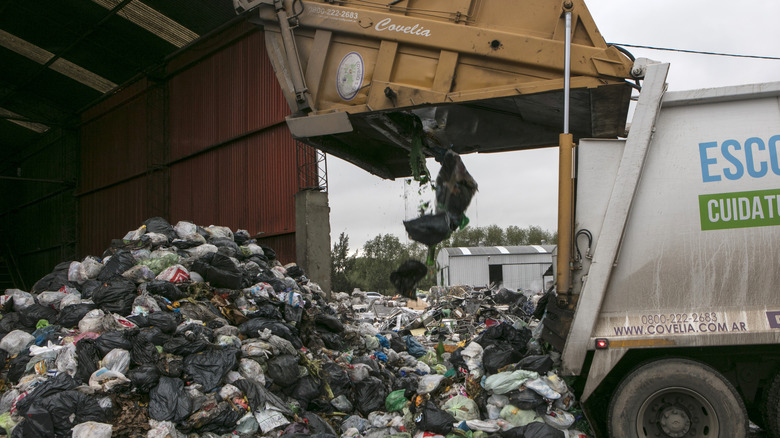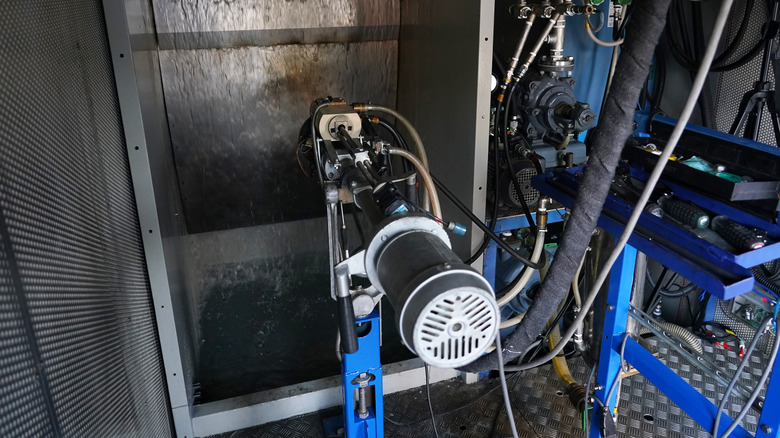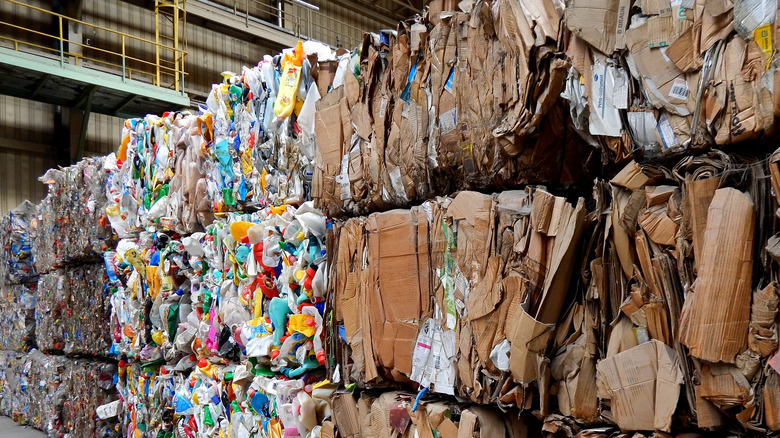Plasma Can Change The Environment More Than You'd Think
Plasma, considered the fourth state of matter, is a staple of science education as well as research. It is essentially superheated or ionized matter in which the electrons are torn away from an atom, leaving positively charged nuclei. Think of it as gas, but instead of neutral atoms and molecules, you have positively and negatively charged ions floating around. Surprisingly, plasma makes up the bulk of matter out there in the visible universe. The sun, which sustains life on Earth, is essentially a giant ball of plasma.
On Earth, the best example of naturally-occurring plasma is the aurora around the poles. On the industrial side of things, the most common usage of plasma is in light bulbs, neon signs, and TVs, but it holds a lot more promise for advancing science. Researchers are using plasma for applications like rocket propulsion, containing biohazards, medical healing, and making computer chips, among others (via MIT).
Surprisingly, there's also an environmental side to the application of plasma, one where it can reduce the dumping of toxic chemicals into the environment and reduce pollution. The disastrous impact of industrial pollution is no hidden secret and Earth has already changed beyond repair, but applying plasma to the way we manage waste can yield promising results. As per a study published in the Journal of Physics, the best way forward is to put plasma to use at plants where waste is burned for disposal.
Why we need an alternative to traditional incinerators
One of the most common methods of solid waste disposal is using incinerators, which essentially burn down municipal and medical waste to reduce their toxic potential and prevent them from hurting the environment. Incinerators are widely used across the world, and the energy produced during the process is also highly coveted. Despite that, there are a few serious health concerns associated with incineration. Likewise, the combustion that happens in an incinerator also produces hazardous chemicals like oxides of sulfur and nitrogen, dioxins, furans, lead mercury, and chlorinated organic compounds, among others.
Incinerators need to be operated with a high degree of care and precision when it comes to variables like combustion temperature and pressure in order to ensure that they do not produce harmful chemicals that are a by-product of partial combustion, as explained in "Waste Incineration and Public Health." To negate the impact, resources like electrostatic precipitators, wet scrubbers, dry-sorbent injections, and similar are required to safely dispose of various chemicals produced during the process, but they don't come cheap.
That, coupled with the lack of technical expertise, can be a huge obstacle to safely running waste incineration plants in developing countries. Studies suggest that waste incineration can lead to health issues such as cancer, respiratory problems, congenital abnormalities, neurological irregularities, hormonal irregularities, and miscarriage, to name a few. Moreover, they can further exacerbate environmental problems like the acidification of water bodies and global warming, not to mention chemically impacting the ozone layer, triggering eutrophication, and creating photochemical smog.
Benefits of plasma for waste incineration
A key advantage of plasma is that a relatively small volume of it can produce an extremely high amount of thermal energy for the disintegration of waste material. In a nutshell, plasma provides an extremely efficient method of waste disposal. During the tests, the team conducted gasification of crushed wood, in which the plasma torch operating at a low flow rate completely turned the wood into a mix of hydrogen and carbon monoxide commonly known as syngas.
"The process can act as an energy storage whereby electrical energy is converted into plasma energy and then stored as chemical energy of the produced syngas," says the research paper. However, the biggest advantage of using plasma for waste disposal is that it leads to the complete breakdown of waste material, which means all organic compounds are broken down into a gaseous form because of the high temperature.
That's a huge advantage, as incomplete combustion of waste material in incinerators is known to produce hazardous materials. Plus, unlike the combustion happening in incinerators, there is no need for an oxygen plant where plasma is involved. Another advantage is that by altering the composition of the gaseous material that creates the plasma torch, the temperature range produced by the plasma can easily be altered depending on the waste material being fed.
Solving the thermal problem
One would think that plasma can only be used as an efficient method for solid waste disposal if it is creating high temperatures in the range of a few thousand Kelvins. But there is also a non-thermal side to plasma that can be as effective. Also known as cold plasma, a non-thermal plasma can operate in the same range as room temperature, thus ensuring that the energy uptake for generating and maintaining a plasma state is much lower. So far, scientists have experimented with multiple methods of creating non-thermal plasma such as shooting an electronic beam, employing a dielectric barrier discharge, and using a pulsing corona discharge.
Irrespective of the generation method, non-thermal plasma has been regarded as an effective method of removing nitrogen oxides, which are known to be the key reason for acid rains. Moreover, when employed alongside a metal catalysis system, cold plasma is also known to be quite effective at getting rid of volatile organic compounds by converting them into carbon dioxide and water vapor.
Another major advantage is that all the waste disintegration can happen at atmospheric temperature, which means there is no need for a specialized containment chamber or the need to spend additional energy to maintain high-pressure conditions. Plus, by simply altering the chemistry of non-thermal plasma, it can be used to treat a wide range of waste material with a relatively lower amount of effort and resources.
Beyond waste incineration
The main by-products of plasma-backed waste management are syngas and a rocky solid material made out of metal and other inorganic material that looks somewhat like shards of glass. The latter can be used as a filler for construction material. Plus, its crystal structure prevents whatever chemicals it holds from leaching into the soil and polluting it. As for the metallic parts in the waste, they seep below the silicious glass-like mass and can subsequently be extracted and recycled.
The tech is already being used in Japan, and according to an article published in The New York Times, projects worth hundreds of millions of dollars had already been greenlit on U.S. soil as of 2012. According to a CNBC report from 2015, a company named Advanced Plasma Power has developed a method called Gasplasma — an amalgam of gas treatment and plasma incineration — that produces valuable syngas and a solid byproduct called Plasmarok that can be used as a construction material.
Research is also underway on a plasma-based device that rearranges the chemistry of hydrocarbon fuels in vehicles to reduce the resulting air pollution from exhausts. Plasma-driven devices can be used to handle chemical spills, and can also be deployed as potent pollution detectors. Moving over to water pollution, low-power portable plasma devices have already proved to be effective at sanitizing water in natural reservoirs like ponds and rivers, thanks to the sterilizing properties of the UV rays generated by a low-pressure plasma arc.




